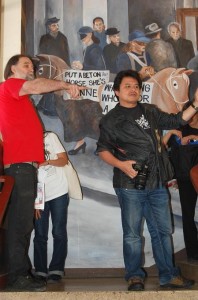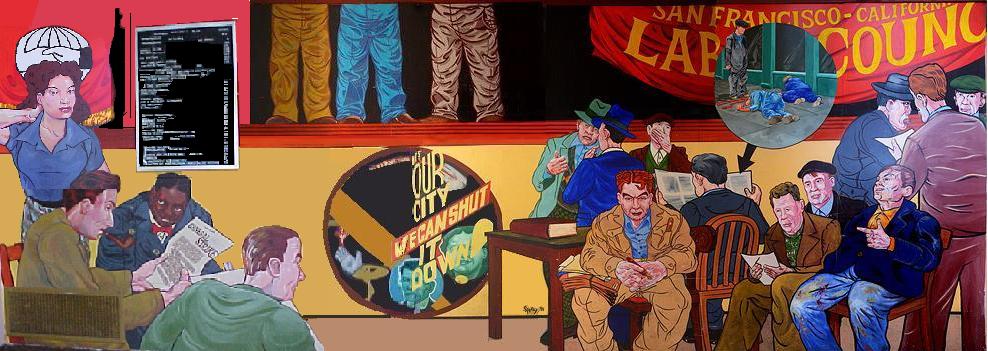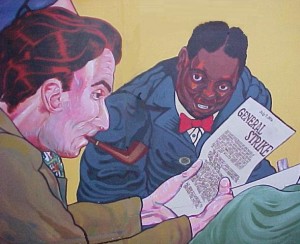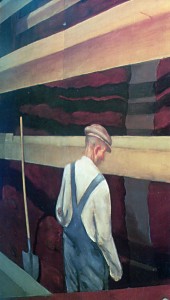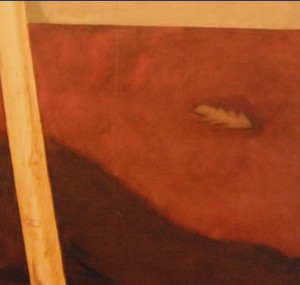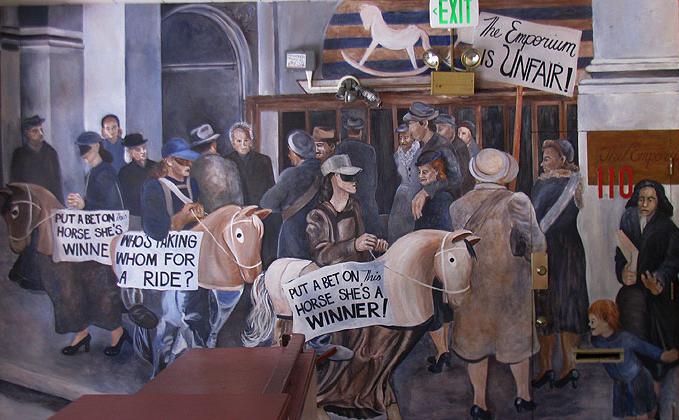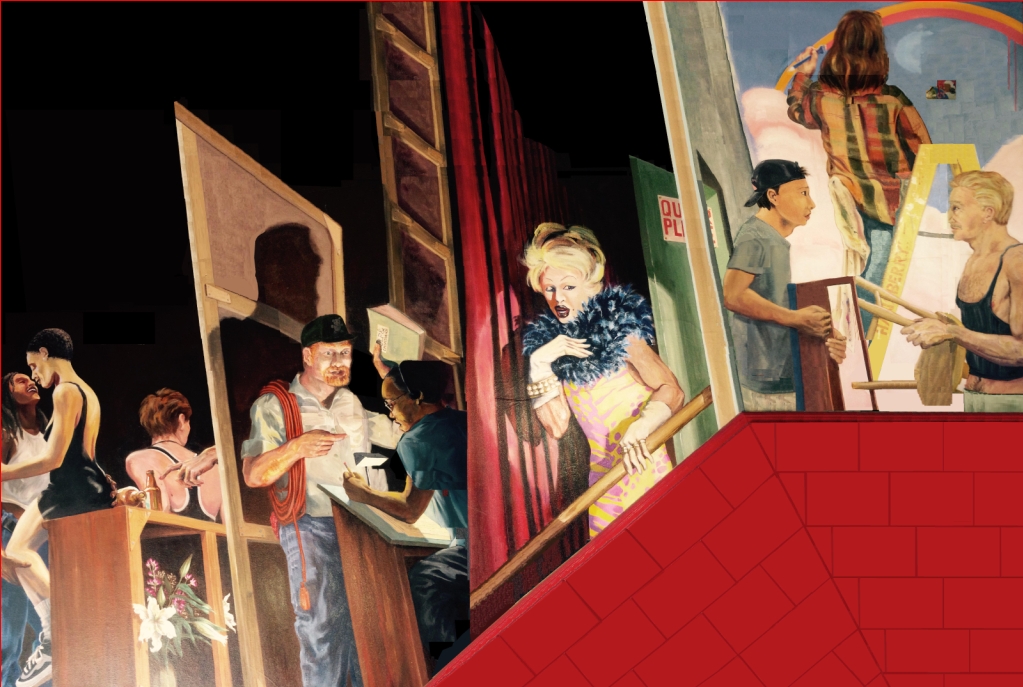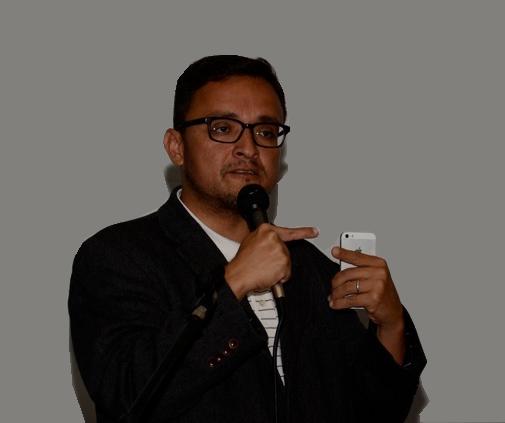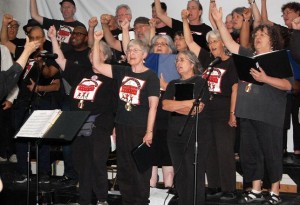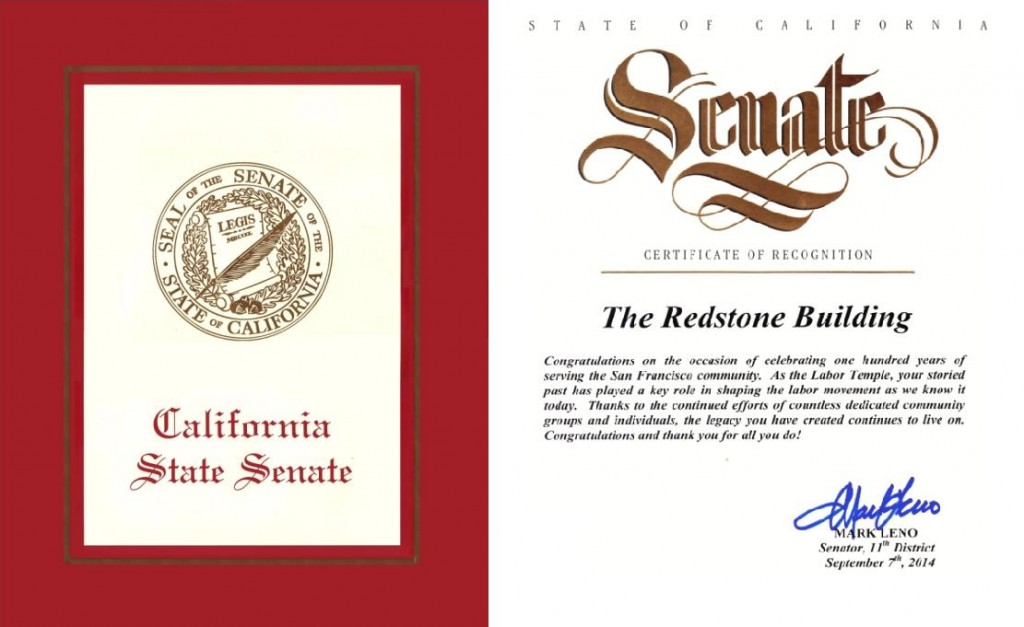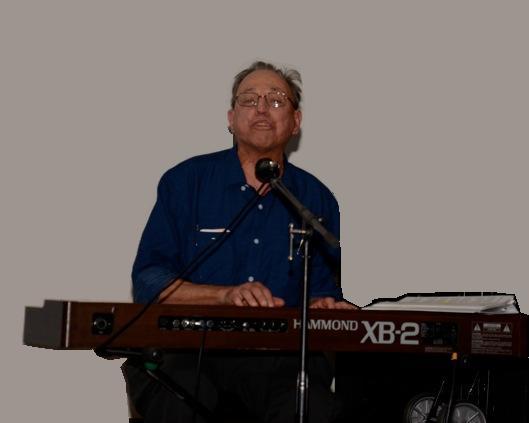100th Anniversary of Cornerstone Placement Celebration
[wptabs mode=”horizontal”] [wptabtitle] Event[/wptabtitle] [wptabcontent]
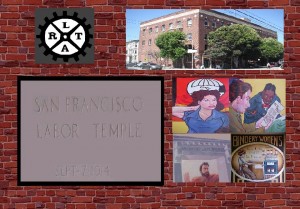 Exactly one hundred years to the day, the Redstone Labor Temple Association (RLTA) commemorated the placement of the cornerstone for the former San Francisco Labor Temple, known today as the Redstone Building. On labor day a century ago, the San Francisco Labor Council celebrated with a speech by mayor Sunny Jim Rolph, a marching band and a thousand people.
Exactly one hundred years to the day, the Redstone Labor Temple Association (RLTA) commemorated the placement of the cornerstone for the former San Francisco Labor Temple, known today as the Redstone Building. On labor day a century ago, the San Francisco Labor Council celebrated with a speech by mayor Sunny Jim Rolph, a marching band and a thousand people.
This time around, we had a speech by David Campos, our representative on the Board of Supervisors and a proclamation congratulating the Redstone building by California State Senator Mark Leno. The Secretary Treasurers of the labor council (AJ Gallagher – 1914 — Tim Paulson – 2014) then and now were in attendance with a speech by FX Crowley, grandson of another Secretary Treasurer from 1972-1985. He’s from Local 16 of the International Alliance of Theatrical Stage Employees, Moving Picture Technicians, Artists and Allied Crafts and has been on the Executive board of the San Francisco Labor Council since 1994.
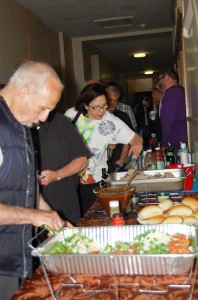 The event started out at noon, with an open house for current tenants, followed by a tour of the building. This was followed by the main program of music, a slideshow about the building and speeches, finishing with feast. This event is the 2nd in a series of events hosted this year by the RLTA, with the first event held on July 5th, that celebrated the 80th Anniversary of the 1934 General Strike. There will be another event in February 2015 to commemorate the grand opening that took place on February 27th, 2015.
The event started out at noon, with an open house for current tenants, followed by a tour of the building. This was followed by the main program of music, a slideshow about the building and speeches, finishing with feast. This event is the 2nd in a series of events hosted this year by the RLTA, with the first event held on July 5th, that celebrated the 80th Anniversary of the 1934 General Strike. There will be another event in February 2015 to commemorate the grand opening that took place on February 27th, 2015.
Please click on the tabs above for more details about the event.
Thanks to Patricia Lee for photos of the event.
[/wptabcontent][wptabtitle] Tour[/wptabtitle] [wptabcontent]
The Tour was led by its current building manager Roger Herried. Due to a full schedule, the tour focused on the first floor murals and main auditorium which is leased today by The Lab, one of the city’s last performance arts spaces left.
About 75 attendees filed into the western half of the original auditorium where Roger would talk about various spaces, starting with the basement that used to have two banquet halls with the larger “Jinks Hall” that could seat up to 600 people.
The main auditorium was originally split in two with the Assembly Hall, having its own entrance, that included Pool Tables and place for workers to congregate. The auditorium played a significant role during its many years as a place where the movement came together during important moments like the 1934 General Strike. In 1970 the auditorium would be given an eight foot ceiling and where it became a state unemployment office for a number of years. In the 1980’s it served as the community center for the San Francisco Philippine community.
The tour then moved to the first floor where each of the murals were briefly described (see the mural tab for more details). With the main program next, more details about the building would have to wait for the slide presentation. Check back here when more details will be added here about the other floors.
[/wptabcontent][wptabtitle] Murals[/wptabtitle] [wptabcontent]
The tour then focused on the murals that were dedicated January 25, 1997. The murals were painted by nine artists from the Clarion Alley Mural Project with a grant from the city that The Lab had obtained during Mayor Willie Brown’s administration.
The $40,000 cost for the murals originally came from a $1.8 million federal grant requested by Mayor Art Agnos for the Mission district’s Latino community to buy the Armory on the corner of 14th and Mission Street.
The grant was insufficient to cover the renovation costs of the former state militia site. So the coalition of Latino organizations led by Mission Legal Defense (a former Redstone building tenant) spent years looking for another building to purchase, including the Redstone building as an alternative candidate, but failed to come to agreement. Brown would take the money and give it to the arts community. Sadly, the Redstone building wasn’t selected for purchase, but did get our murals.
The most prominent of the murals in the main lobby was done by Chuck Sperry that is based on images from the 1934 General Strike that followed the death of two workers on July 5th, following weeks of confrontations between waterfront workers and the port’s employees. Chuck’s drawing is a composite of a number of photographs during the 1934 strike. The first image is of Howard Sperry and Nicolas Bordoise laying dead, with the other being Harry Bridges in a circle of men looking at one of the strike documents. The man with bright red hair is Vincent Hallinan, the lawyer that defended Harry from deportation over the next twenty years. In the upper left is Jennie Matyas a organizer with the International Ladies Garment Workers Union who played a prominent role in organized Asian women workers in the city.
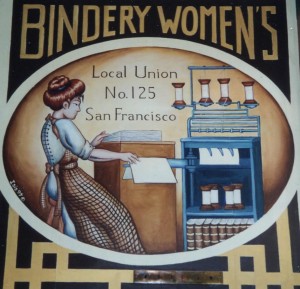 Over the elevator and Immediately to the right is a mural depicting of the Women’s Local 125 Bindery Union. This mural was done by Isis Rodriguez depicting their union that was an early tenant at the SF Labor Temple between 1915-17. Isis is a Latina from the mid-west that became part of movement known as “The Mission school” that included the Clarion Alley Mural project in the mid 1990’s. The women’s local was started in 1902 but reluctantly agreed to merge with the men’s local bindery union. The Labor Archives Research Center at San Francisco State has an extensive set of materials about the Women’s union and has done special events around the local in the past.
Over the elevator and Immediately to the right is a mural depicting of the Women’s Local 125 Bindery Union. This mural was done by Isis Rodriguez depicting their union that was an early tenant at the SF Labor Temple between 1915-17. Isis is a Latina from the mid-west that became part of movement known as “The Mission school” that included the Clarion Alley Mural project in the mid 1990’s. The women’s local was started in 1902 but reluctantly agreed to merge with the men’s local bindery union. The Labor Archives Research Center at San Francisco State has an extensive set of materials about the Women’s union and has done special events around the local in the past.
Directly opposite of Sperry’s mural in the lobby, along the south wall of the building is John Fadeff’s work. His earth tone mural includes a measuring stick across the top, a large shovel to the left of the door, and on the right, a union man alongside a shovel working on the Labor Temple back in 1914. The large shovel to the left of the door includes a small artifact about eight feet off the floor that was an Ohlone artifact found while excavating the site.
To the left of the door, and up the stairs that lead to the first floor is Susan Greene‘s depiction of the 1941 department worker’s union strike at the Emporium on Market and 5th. Strikers wore all kinds of nifty costumes depicting robots, to the women riding hobby horses during the two month long strike. Susan is a tenant at the building as well as on the faculty at the San Francisco Art Institute.
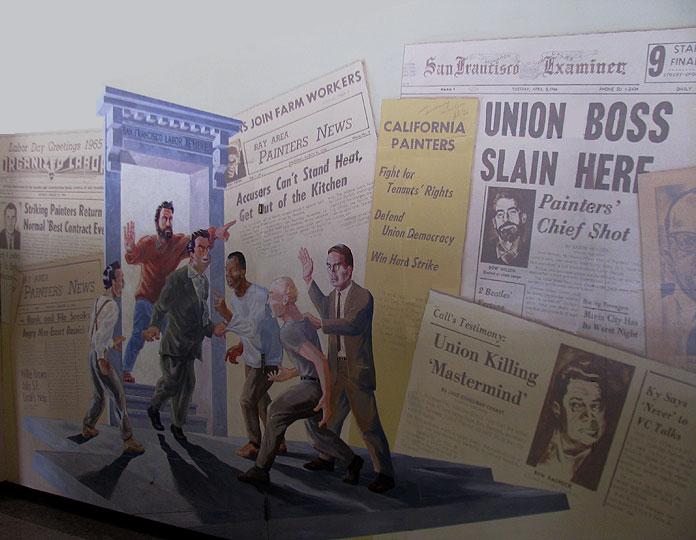 The last labor related mural is Aaron Noble‘s depiction of the assassination of Dow Wilson on the first floor reminds us of a tragic moment in 1966 when the the young labor leader for local 4 of the painters union lost his life.
The last labor related mural is Aaron Noble‘s depiction of the assassination of Dow Wilson on the first floor reminds us of a tragic moment in 1966 when the the young labor leader for local 4 of the painters union lost his life.
This mural was the last of the murals added to the first floor and was done by Aaron Nobel. Aaron was coordinator for the murals project at the building and is the 2nd of his two murals he did. Its located on the 2926 stairway that exits the building on the east side of the building. The mural depicts front and backstage activities during a rehearsal. The Theatre Rhinoceros was a tenant at the building for over 30 years but was forced to leave the building in 2010 due to major rent increases. They were the first gay theater in the US. It should be noted that the theater used Union actors at all of its events.
Details for all of the Redstone Building Murals can be found here.
The artists: Aaron Nobel (project Coordinator), Chuck Sperry, Rigo 97, Barry McGee, Susan Greene, Matt Day, Ruby Neri, John Fadeff, Scott Williams, Carolyn Castano, Sebastiana Pastor and Isis Rodriquez.
[/wptabcontent][wptabtitle] Program[/wptabtitle] [wptabcontent]
After the tour everyone went to the 2nd floor for the main program. The program was held in one of the original seven meeting halls for the Labor Temple, originally known as Federation Hall, and was last used as a hiring hall by Local 110 of the Culinary Workers. The Master of Ceremonies was Karl Kramer from the San Francisco Living Wage Coalition. The first speaker and special guest was David Campos, our representative on the San Francisco Board of Supervisors. His speech is below.
The program then launched into a rousing set of labor songs by San Francisco’s Rockin’ Solidarity Labor Chorus. The fifty piece choir is led by award winning Pat Wynn, accompanied by Bernard Gilbert. The audience was treated to familiar and some not so familiar songs that included speaking pieces as well as solos. It was topped off with the International with everyone raising their fists to its anthem.
Their set included:
- You Got to Go Down and Join the Union (Guthrie)
- Keep Our Union Strong ( Music – May the Circle be Unbroken – Guthrie)
- Jay Gould’s Wants (Wynn)
- The Eight Hour Day
- As Soon as this Pub Closes
- Honor the Picket Line
- When May Day Comes
- We Shall Not Give up the Fight
- The International
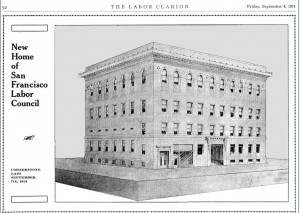 Immediately following the choir was a 35 minute long slideshow on the history of the San Francisco Labor Temple (known today as the Redstone building) construction going back to the 19th century. It included details of how the San Francisco Labor Council formed the San Francisco Labor Hall Association to construct a labor temple after the 1906 earthquake at the corner of 14th and Mission, where the council and its affiliates met until deciding to build a much larger temple at 16th and Capp. The story included many images that have been lost for decades, along with news stories about the struggle to build the SF Labor Temple between 1910-15. The Temple would eventually cost just under $135,000, with all funds raised directly from working families during a two year recession when an average workers pay was only a few dollars a day.
Immediately following the choir was a 35 minute long slideshow on the history of the San Francisco Labor Temple (known today as the Redstone building) construction going back to the 19th century. It included details of how the San Francisco Labor Council formed the San Francisco Labor Hall Association to construct a labor temple after the 1906 earthquake at the corner of 14th and Mission, where the council and its affiliates met until deciding to build a much larger temple at 16th and Capp. The story included many images that have been lost for decades, along with news stories about the struggle to build the SF Labor Temple between 1910-15. The Temple would eventually cost just under $135,000, with all funds raised directly from working families during a two year recession when an average workers pay was only a few dollars a day.
Ruach Graffis (Vice President of the Redstone Labor Temple Association) would then present Roger Herried (Building Manager) with the California Senate proclamation for the 100th anniversary celebration of the building.
This was followed by labor songs by Dave Welsh. Dave is a member of the local postal workers union and played an important role in the successful campaign to stop the sale of Berkeley’s post office to Diane Feinstein’s husband. His Songs were:
- Nothing to Lose (but our chains)
- Which Side Are You On?
- Class War Going on (In America)
FX Crowley then gave a speech about the kind of vision the union movement should have to get it back on track. FX is the grandson of John Crowley, who was the Secretary Treasurer of the Labor Council from 1972-85. FX remembered playing in the halls of the building as a child…
The last performance in the program was by Maria Machete:
Sasalo Pa’ Afura
Si Me Ser
This was followed by a social hour that included food.
[/wptabcontent] [/wptabs]
